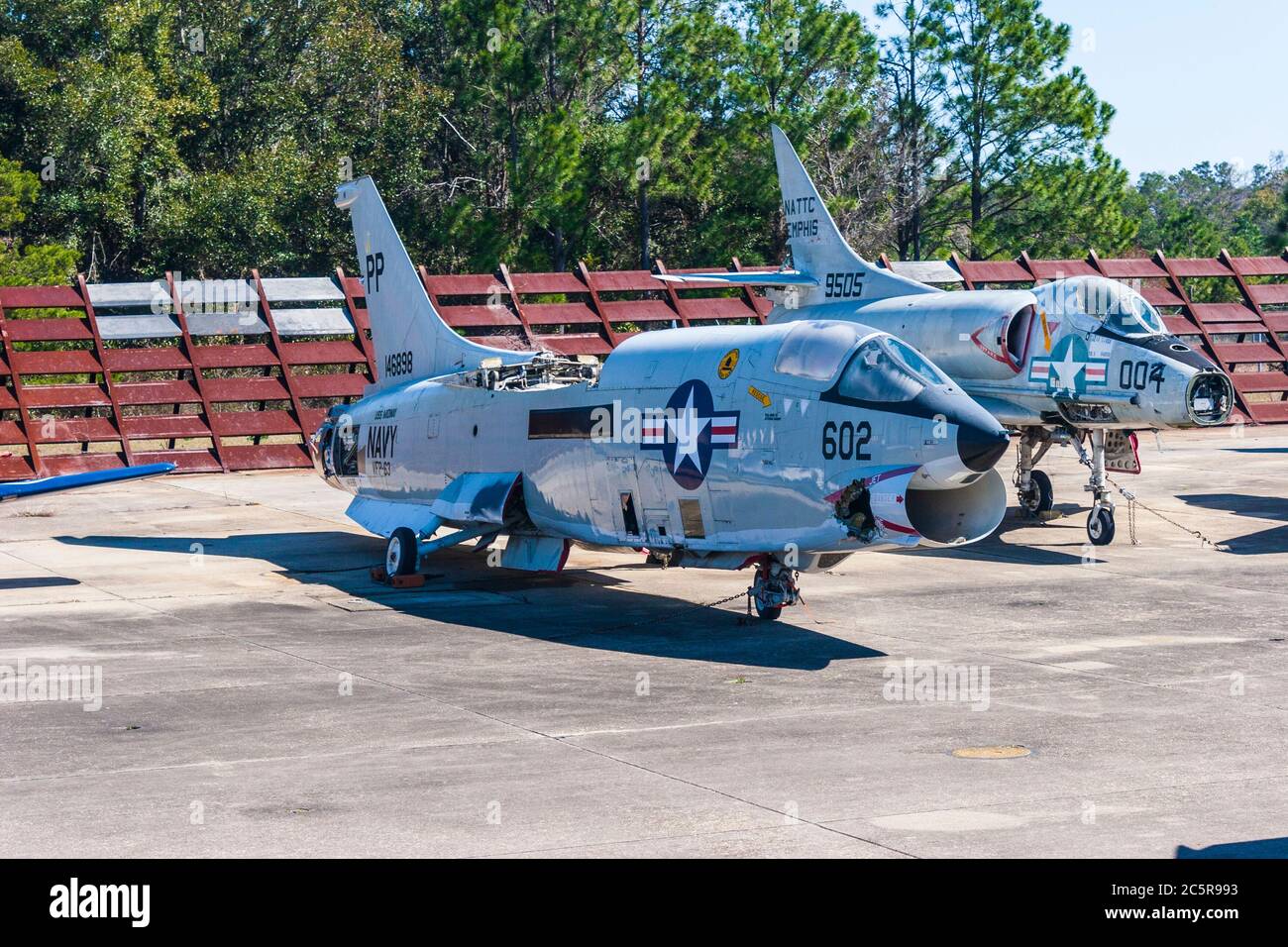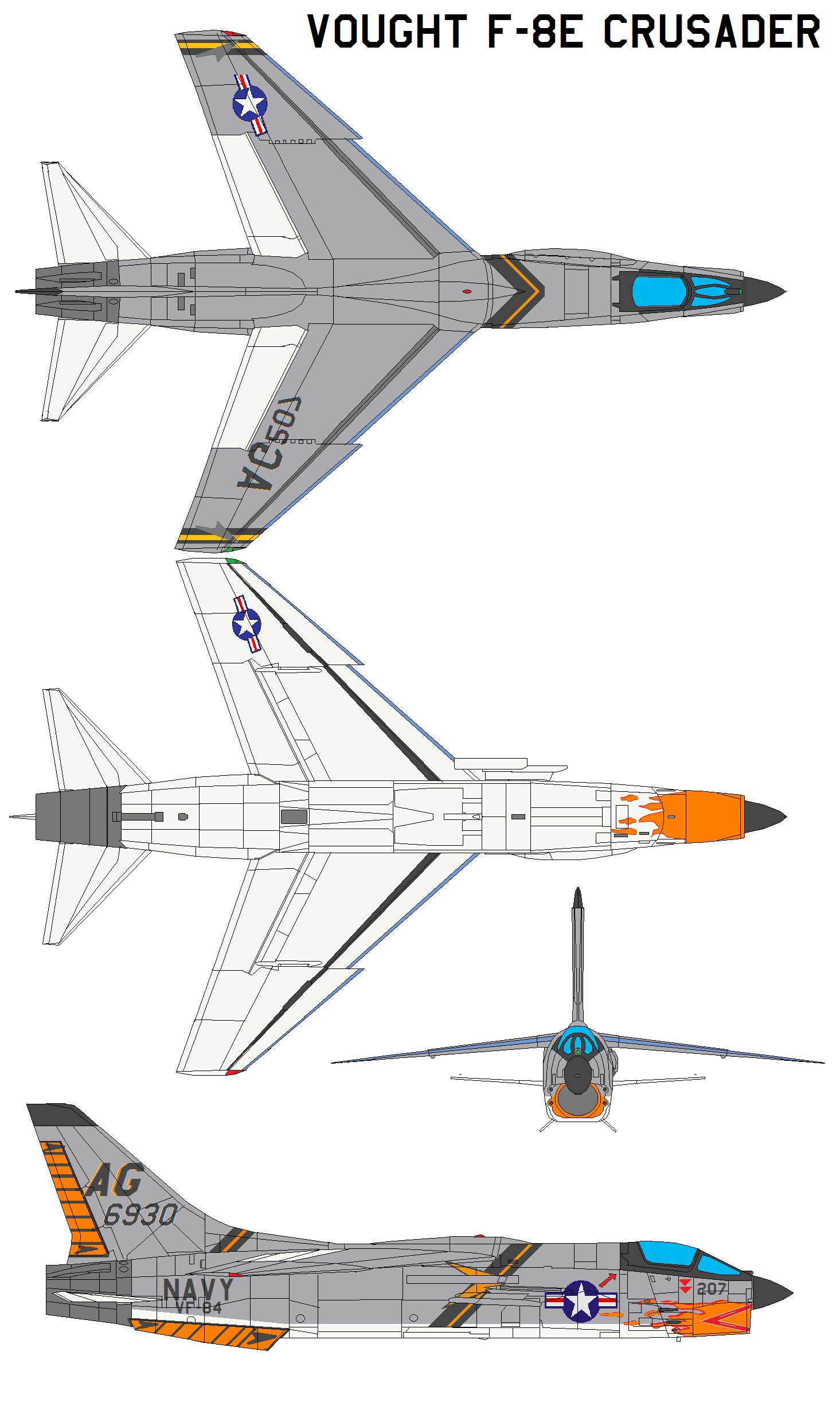F 8 Fighter - English: The Vought F-8 Crusader was designated the F8U with the US Navy (and with the US Marine Corps) until 18 September 1962 when, with the introduction of the Tri-Service aircraft designation system, all Crusaders still in service were renamed the F -8 .
F 8 Fighter

GND ID: 4816661-3 Library of Congress Authority ID: sh85034378 NKCR AUT ID: ph717865 United States National Archives Identifier: 10665656 National Library of Israel J9U ID: 987007535965705171 De Chance Voughter. Vanwege is tasked as fighter droeg hij de typanduiding F-8.
F 8 Crusader Units Of The Vietnam War (ebook), Peter Mersky
The first flight was created by an apparatus in February 1955; the Crusader was declared operational by the USN and USMC recruiter in January 1957. A total of 1260 of this type were delivered.
For the Vietnam War, the F-8 Crusader was the last American fighter jet with the cannon as the primary weapon system. The outfits that have been developed here rely solely on rocket bewapping. By experiencing it in the Vietnam War, however, fighter jets became all about the gun. Het bleek dat de appareilen die allene over raketten haftten in een 1 tegen 1 dogfight meeten al achterstand had.
The Crusader was the door to their cannon armament and their enormous kindness a lot to go in dogfights and took the rank and file aircraft with their cannon armament down. The device was operated with great success as an escort-an interceptor fighter.
In 1964, the first F-8 E Crusader was also delivered to the French marineluchtvaartdienst Aéronavale. The total strength is 42 pcs. These units were somewhat gemoficeerd ten beheve van operations van the smaller French flight decks Clemenceau en Foch. In the last period of 1999, the door came to the door of Franse Dassault Rafale M.
Philippine Air Force, Vought F 8 Crusader
In 1977, 35 Crusaders aan de Filipijnse luchtmacht gelevert ter verwenning van de verouderde F-86 Sabre. Before the Vietnam War, leadership in the US Air Force and US Navy felt that superior technology, in aircraft and weapons, would lead to air superiority over any enemy aircraft. Fighters like the F-4, with powerful radar and missiles with beyond visual range would sweep the air of enemy fighters. Older fighters, it was thought, would not do justice as well as the F-4. The air war over North Vietnam, especially the fight against the North Vietnamese MiG aircraft, received a lot of attention from the media and military leaders because it would put this theory to the test, albeit against a vastly inferior enemy. From 1965 to 1968 and then again in 1972, American aircraft flew almost daily combat over North Vietnam against a much smaller and vastly inferior enemy. The US Air Force found that its reliance on technology was not up to the task of providing air superiority over North Vietnam and US air forces. This was far below the ratio of 14 to 1 dead claimed during the Korean War. closer to 8 to 1). This poor death ratio was of great concern to the US military leadership. The Vietnamese air force, which claimed to be poorly trained and equipped with mostly veteran fighters, proved it could hold its own against a much larger and well-equipped enemy. tactics, and aircraft were not up to the task in Vietnam, except for one plane. The Navy's F-8 Crusader, manufactured by Vought, managed a much more respectable 6 to 1 kill ratio, and with probable claims added to the equation, a 7 to 1 kill ratio was achieved in the first three years of the Vietnam War.
How did the Crusader pilots make such a dramatic difference in success compared to newer and more advanced American fighters? A comparison between the F-8 and its two opponents in the Vietnam War, the MiG-17 and the MiG-21 shows that the F-8 -8 was fairly evenly matched against both MiGs. The F-8 was a proven aircraft in 1965 with fair maneuverability along with a respectable array of weapons and a mature training program. The F-8's tactics and training were based on its extreme scarcity. visual range weapons and relies on the rear quarter of IR missiles and four 20mm cannons. The nature of the air war over Vietnam handcuffed the American forces with many disadvantages. Strict rules of engagement, weather and long flying distances were some of the disadvantages that allowed North Vietnamese MiG pilots to choose the right time to attack. This made air combat a visual maneuver affair, one the F-8 pilots were well aware of. t could easily convert to a wartime, it was key to the success of the F-8 over North Vietnam.
The F-8 was built with one goal in mind: to find and shoot down enemy aircraft. The Crusader was armed with four Colt Mark-12 twenty millimeter cannons and could also carry four Sidewinder AIM-9 missiles. The Mark-12 cannon can fire 660 rounds per minute but tends to misfire.

F-8 squadrons found that regular use and maintenance of the Mark-12 would reduce interference incidents during training. Unfortunately, the training environment, whether firing at a target on the ground or shooting a target flag at 30,000 feet, did not simulate the stresses of aerial combat over North Vietnam. F-8 pilots often practiced aerial gunnery - into the air by shooting a canvas flag, impregnated with some radar-sensitive material, which was towed by another fighter. The pattern was flown normally at 20,000 feet and the supersonic pattern was flown at 30,000 feet.
Amazing Facts About Vought F 8 Crusader
To get hits on the flag, a pilot must fly a smooth and precise pattern through the air. Although G-forces during shooting can approach 6G, the G-force is usually applied with a smooth, steady pull. Contrast this with air combat where a fighter plane tries to get into firing position on another plane moving in three dimensions. The struggle is characterized by a rapid onset of G-forces followed by a rapid release or negative G-forces. This difference between firing situations in training and combat caused the problem of stopping return guns during missions over North Vietnam.
Unfortunately, funding for this site is currently at a very low level. If you have liked an article, you can contribute here.
The AIM-9 sidewinder used by the F-8 was a short-range infrared homing missile. The F-8 used two different variants of the AIM-9 during the early part of the Vietnam War, the AIM-9B and the AIM-9D. The AIM-9B/Ds during the Vietnam War were limited because they had poor IR sensitivity, which led to a tendency to track a heat source on the ground towards the target aircraft. The AIM-9s during this period had to be fired at the rear quarter of enemy aircraft and were also very limited in its ability to track and hit a moving target. The AIM-9B could only be effective at less than 20 degrees tail angle (AOT). by enemy aircraft. The AIM-9B could only be fired effectively with less than 2 G's on the launch plane. The AIM-9D had a cooled probe head that gave it better heat discrimination and a better engine for better performance.
The AIM-9D can be effective up to 40 degrees AOT, but
Mig Master F 8 Crusader Patch
F 8 fighter jet, f 18 fighter jet, f 16 fighter plane, f-8 fighter, f 16 jet fighter, f 16 fighter aircraft, f 35 stealth fighter, f fighter, f 15 fighter jet, f 35 fighter aircraft, f 35 jet fighter, f 35 fighter
0 Comments